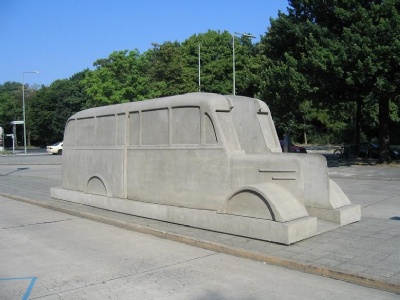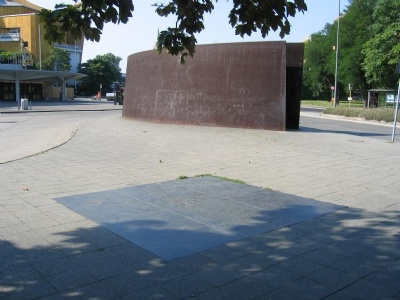Berlin – T4 HQ
In October 1939, Hitler instructed his personal physician, Dr. Karl Brandt, and the head of Führer’s Chancellery, Philip Bouhler, to prepare a program in which doctors were given mandate to kill physically and mentally handicapped patients in hospitals and clinics. These were considered incurably ill or carrying hereditary diseases which in the long term threatened the survival and resilience of the Aryan race and were a (economic) burden to the state. They also believed they were doing these people a favor by letting them die instead of living an unworthy life. The instructions given to Bouhler and Brandt was written and signed by Hitler on his personal stationery and dated back to September 1, 1939, the day the war broke out.
Administration, planning and implementation were placed under the Führer Chancellery and in close cooperation with the interior ministry. Its headquarters were located in a building on Tiergartenstrasse 4 in Berlin and was subsequently called T-4 program. The person who came to organize it all was Viktor Brack. Already in the summer of 1939, registration and murder of children with mental and physical disabilities had begun at various children’s hospitals or child wards. At the same time, preparations were under way to extend these merciful killings (euthanasia) to adults, and when the war broke out, it could take place in the shadow of the war.
After the invasion of Poland in 1939, the Germans began to murder Polish citizens admitted to mental hospitals in Poland. Some of these were shot, others were murdered in gas wagons where the truck’s engine exhaust was led into the hermetically dense cargo space where the people died of carbon monoxide poisoning. In October 1939, a gas chamber was set up at Poznan - fort VII (german Posen), where Polish citizens who had been taken from mental hospitals in Poland were killed.
Those in charge of T-4 realized the benefits of specially built gas chambers (carbon monoxide) because it gave them opportunities to murder on a large scale. In 1940 and 1941, six euthanasia centers were established to murder handicapped people, Brandenburg, Bernburg, Grafeneck, Sonnenstein, Hartheim and Hadamar. The people murdered had been sent to one of the centers by T-4 doctors. The doctors never examined the patients physically, only by formular they decided if the patient should be put to death. The formulas were then sent to a special transport unit who collected those chosen to be killed at the clinics/hospitals. They were then taken to a transit clinic before finally being sent to an euthanasia centre. The patients were usually murdered same day they arrived and they were cremated in specially built crematoria on site. The T-4 administration then wrote false death certificates, false condolence letters with false dates of death. Both death certificates and condolence letters were signed by T-4 doctors.
Both Hitler and those responsible within the T-4 were fully aware that the killings of germans was a sensitive subject and therefore not officially, but not a secret either. Therefore, various coverings were created to conceal or mislead both the population and victim’s relatives. But in the long run it was not possible to hide what was going on, it was mainly influential Catholic priests who at sermons spoke about the killings of German citizens. Hitler ordered an official stop to the killings in August 1941. There was a serious concern from top nazis that the killings would lead to excessive protests. Something they wanted to avoid now when the war against the Soviet Union was in full swing. By August 1941, some 70,000 German citizens, either suffering from a hereditary disease or suffering from a mental or physical disability, had been murdered in the T-4 programme.
It was mainly adults who were murdered in the T-4 program, but that did not mean that children were spared. Some children were murdered on the same grounds as adults within the T-4 program. But there was also a side track called child euthanasia. Up to thirty hospitals in Germany, had children wards where mentally and physically disabled children were sent and eventually killed by tranquilizers. The number of children killed in child’s euthanasia is estimated to 5,000.
The official stop of T-4 did not mean that the "mercy killings" had stopped. By the spring of 1941, euthanasia had spread to the concentration camps. There, under the assumed name, 14f13, they had begun killing, along with other unwanted prisoner, physically and mentally handicapped prisoners no longer capable of slave labor. They were sent to either Bernburg, Hartheim or Sonnestein, which had not been liquidated when T-4 was officially stopped. Until the spring of 1943, about 10,000 prisoners from concentration camps had been killed under 14f13.
In addition to 14f13, there was also a decentralization of the mercy killings. If the "official" euthanasia program had been centrally controlled from Berlin, it was now decentralized down to the hospitals and clinics themselves to decide who should be put to death or not. The patients were killed on site, mainly through starvation or medication, but some were shot in nearby forests. They were later buried in unmarked mass graves. It is estimated about 87,000 people were killed in the decentralized euthanasia. Then there were also something called, special euthanasia actions, in occupied areas, where another 50,000 people were killed. A total of about 300,000 people were killed within the framework of the Nazi euthanasia between 1939 and 1945.
Current status: Demolished with monument (2008).
Address: Tiergartenstrasse 4, 10785 Berlin.
Get there: Metro to Potsdamer Platz Station.
Follow up in books: Friedlander, Henry: The Origins of Nazi Genocide – From euthanasia to the final solution (1995).



Tiergartenstrasse 4 was heavily bombed during the war and demolished. Since the sixties, the Berliner Philharmonie is located on the site and outside there is an exhibition about the T-4 program. All six euthanasia centers are now museums.